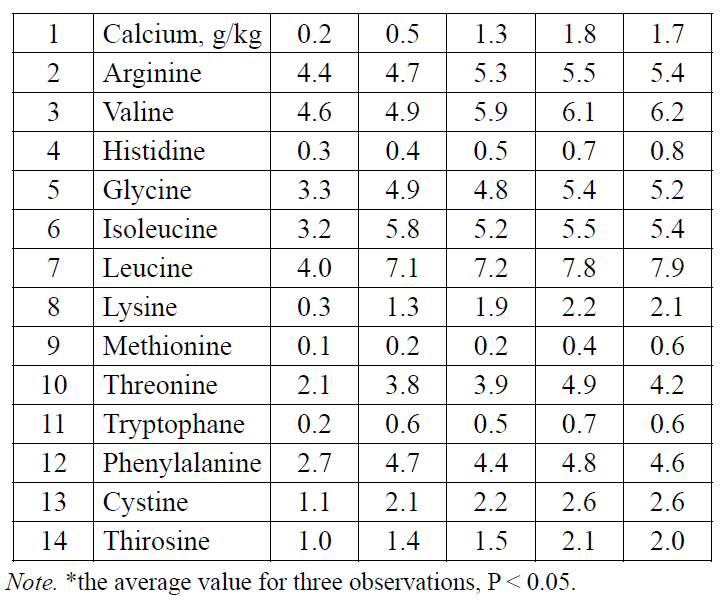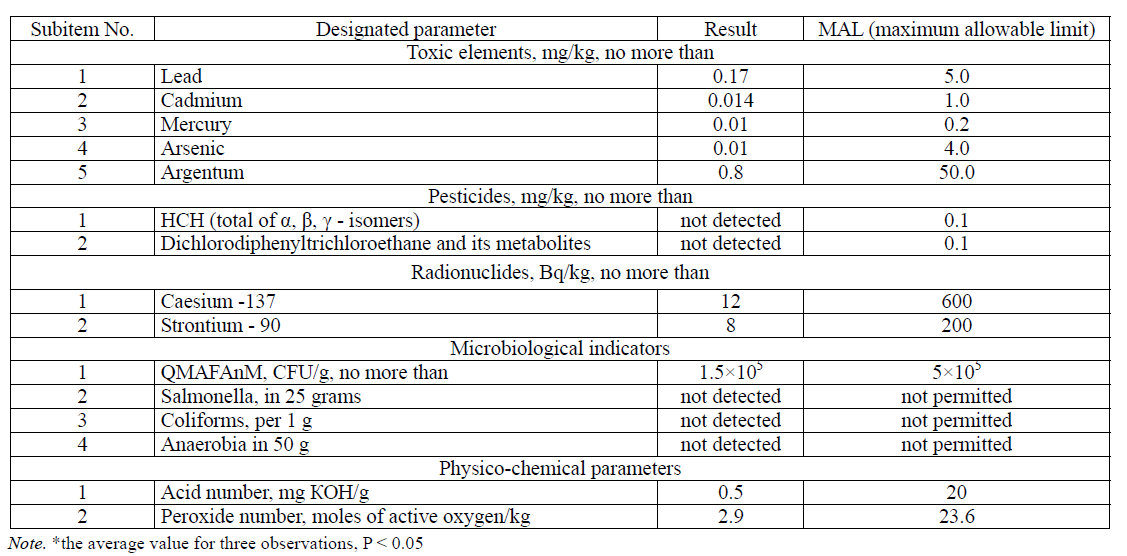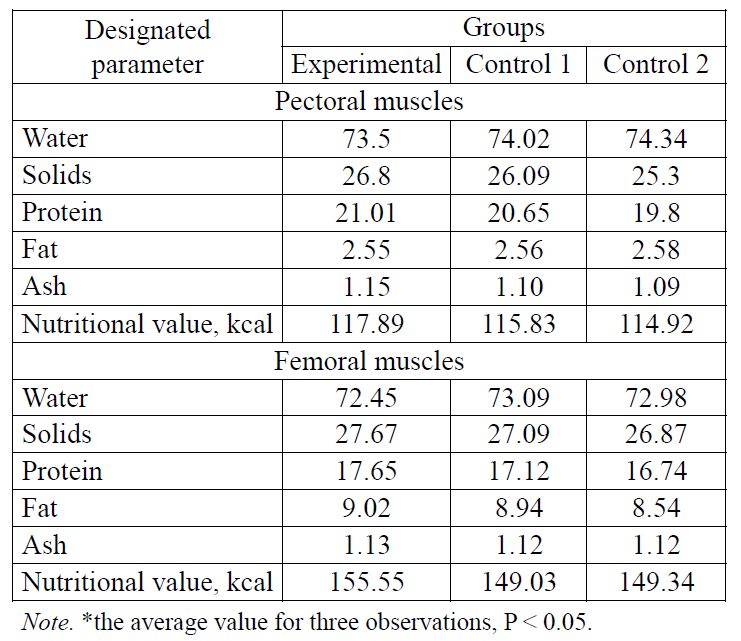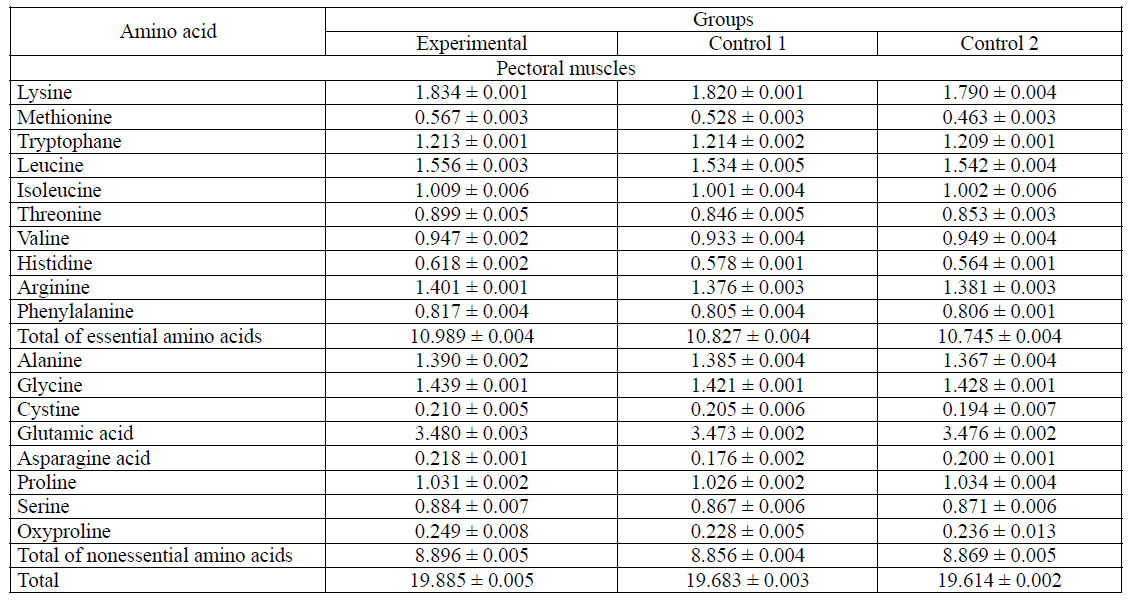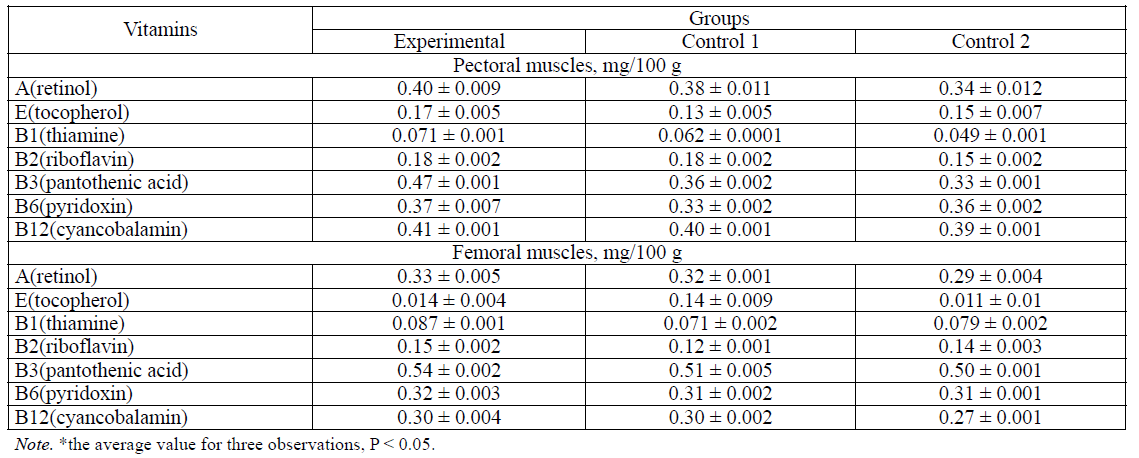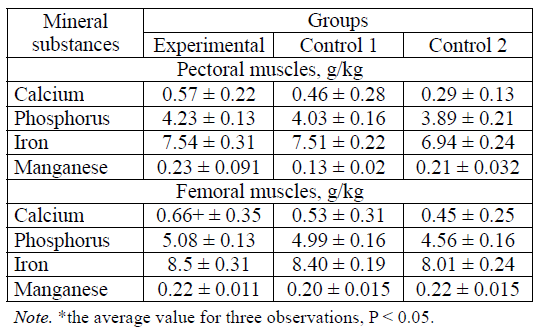Аннотация
Poultry farming is one of the largest branches of agriculture with a high level of production of a variety of organic wastes that require special approaches to useful utilization. The article describes the problem of processing evisceration waste and keeping poultry in quality feed supplements and the estimation of their effectiveness in feeding broiler chickens. In accordance with the studies, it has been established that the studied feed supplements, with a share of feather-down waste of more than 80%, differ in a balanced amino acid composition, a high content of protein (89.9-90.2%) and sulfur-containing amino acids, that is cystine and tryptophan that have a high value in the process of fattening the bird. The ratio of 8 : 2 (feather-down waste : litter) is recognized rational and optimal for a further use - the feed supplement produced using this method contains glycine, the most important amino acid for chickens, and is characterized by a high content of calcium and phosphorus due to the components of litter. According to the safety indicators established by the regulatory documents, the feed supplement is recognized high-quality and safe. When estimating the toxicity of the feed supplement using the test organism Tetrahymena pyriformis , no adverse effect on the survival, mobility, growth and behavior of the cells was detected. When analyzing the relative biological value of the feed supplement using Tetrahymena pyriformis , it has been established that the average number of the cells grown withthe use of the feed supplement is (8.9 ± 0.9) × 104 cells, which indicates its high nutritional value. Taking into account the results of the studies on the chemical and amino acid composition of the feed supplement, the data ofmicrobiological and toxicological studies, and taking into account the toxicity estimation, it has been concluded that the studied supplement is safe and can be used in the birds diet.Ключевые слова
Feed supplement, poultry waste, effective microorganisms, waste bioconversion, microbial disposal, biopreparation, broiler chickensВВЕДЕНИЕ
Poultry farming is one of the key areas of business activity in the structure of agriculture. This is a science-intensive and dynamically developing industry with an annual world production growth rate of 6–9% [1, 2].
In the Russian Federation, along with the significant successes in poultry farming, there is an annual increase in the volume of waste generation of poultry enterprises that now make up more than 17 million tons per year [3, 4].
Waste of evisceration and poultry keeping is the most promising from the point of view of useful utilization and the creation of non-waste technologies. As for the chemical composition - the content of amino acids, the balance of micro and macro elements – feather-down raw materials, litter and other types of waste are a valuable source of nutrients in the production of feed supplements [5, 6]. Table 1 presents the chemical composition of feather-down raw materials. Table 2 presents the amino acid composition of feather-down raw materials in comparison with a human hair, a horse hair and sheep wool.
The existing technologies for processing poultry waste are based on the processes in which the bioavailability of useful components and their decontamination is achieved mainly through a hightemperature hydrothermal treatment or using acidic (alkaline) hydrolysis. Such methods often lead to the loss and racemization of essential amino acids, the formation of cyclopeptides and a significant decrease in the total biological value of the final feed products [7].
High-temperature drying or incineration is used in the technologies for useful litter disposal, which leads to a loss of more than 40% of nutrients. Sometimes formaldehyde is used to disinfect litter, but it alsosignificantly reduces the nutritional and protein value of the feed produced [8, 9].
The analysis of the technologies used shows that the processing industry have some tasks of developing new modern environmentally friendly technologies for recycling waste from poultry enterprises, which allows, at high economic efficiency values, to produce feed, feed supplements and other technical products withimproved characteristics.
A principally new approach of this trend is the creation of the bioconversion technologies based on the use of effective systems of destroying microorganisms [10, 11]. Such microorganisms are able to synthesize enzymes and enzyme complexes into the environment and provide the process of conversion of complex organic compounds that are part of waste into available forms. A unique feature of such strains is the ability to suppress the growth and development of pathogenic microflora of waste [11].
Thus, the study aimed at improving the biotechnological methods for recycling poultry wastes and developing a technology for producing a feed supplement from them is a relevant task, the solution of which is directed both at deep processing and the complete neutralization of waste.
ОБЪЕКТЫ И МЕТОДЫ ИССЛЕДОВАНИЯ
The object of the studies was a feed supplement from a mixture of feather-down raw materials and litter from Lohmann Brown chickens.
The paper aimed at estimating the quality and effectiveness of the developed feed supplement based on a mixture of poultry waste (chicken feather : litter) in feeding Hubbard broiler chickens.
Study of the feed supplement indicators. The process of utilization of mixtures of feather-down waste and litter was conducted under laboratory conditions as follows: the ground waste mixture was fed to a BioStat A plus bioreactor, 5 dm3 in volume, and treated with an active culture of destroying microorganisms: Bacillus pumilus SAFR-032, Microbacterium terregens AC1180, Bacillus fastidiosus B11090, Arthrobacter globiformis AC1529, Streptomyces olivocinereus AC1169, Acinetobacter sp. B3905, which were in a nutrient medium (in the ratio of nutrient medium: microorganisms – 15 : 1). The bioconversion process begins immediately after the application of microorganisms and lasts for 72 hours. Upon completion, the microorganisms must be inactivated. The parameters of inactivation have been selected taking into account the cessation of the effect of extracellular enzymes of microorganisms on the substrate and the termination of the processes of division of the microorganisms themselves. After inactivation, the resulting enzymatic hydrolysis product is filtered using a filter with a mesh size from 1 to 0.5 mm to separate the coarse fraction.
The drying stage is feeding the spray dryer, the excess moisture is removed and the resulting feed supplement takes on a powdery form. The following stages include prepackaging and packaging the supplement.
For comparison, the samples of unprocessed waste mixtures are taken as the control samples:
– the chemical composition of the feed supplement was studied in accordance with GOST 17681-82 "Flour of animal origin. Test methods";
– the amino acid composition of the feed supplement was determined according to the requirements presented in GOST 32195–2013 "Feeds, compound feeds. Method for determination of amino acids" and GOST 32201–2013 "Feeds, compound feeds. Method for determination of tryptophan";
– the acid number was determined according to the requirements presented in accordance with GOST 13496.18-85 " Mixed fodder and fodder raw stuff. Methods for determination of fat acid value";
– the peroxide number was determined in accordance with the requirements presented in GOST 31485–2012 "Mixed feeds, protein-vitaminmineral concentrates. Method for determination of peroxide number";
– the content of toxic elements was studied in accordance with GOST 30692–2000 "Fodders, mixed fodders and animal raw foodstuff. Atomic absorption method for determination of copper, lead, zinc and cadmium";
– the silver content was determined in accordance with GOST 18293–72 "Drinking water. Methods for determination of lead, zinc and silver content";
– the content of arsenic and mercury was determined according to the requirements of MBI FR.1.31.2002.00593 "The procedure for performing measurements of the mass concentration of arsenic and mercury ions in feeds, feedstuff products and feed additives by the method of inversion voltammetry";
– the presence of pesticides was studied according to the "Guidelines for determination of organochlorine pesticides in water, food, feed and tobacco products by chromatography in a thin layer" (approved on 28.01.1980, No. 2142–80);
– to determine the content of radionuclides, a method based on the activity of gamma-emitting radionuclides in the sample using an SRP-68-01 radiometrometer was used. The studied sample of the feed supplement in a flat-bottomed chemical beaker was placed at the bottom of the well. A radiometer detector was placed in the sample of the supplement, which was covered with a plastic bag, so as to provide a position of the lower end of the device at a level of 2–3 cm from the bottom of the beaker.
– the microbiological studies were conducted in accordance with GOST 25311-82 "Feeding flour of animal origin. Methods of bacteriological analysis"; The selection for carrying out microbiological studies was carried out in accordance with the requirements of GOST 17536-82 "Feeding flour of animal origin. Specifications";
– the toxicity of the feed supplement was determined according to the "Methodological guidelines for the accelerated determination of toxicity of livestock products and 56 feeds" (approved by the Veterinary Department of the Ministry of Agriculture of the Russian Federation on 16.10.2000, No. 13-7-2/2156);
– the relative biological value (RBV) was determined according to the "Methodological recommendations for the use of the rapid method of biological assessment of products and feeds" (approved by the All-Union Academy of Agricultural Sciences named after Lenin, 1990);
Estimation of the effectiveness of the use of a feed supplement in feeding broiler chickens. In the course of the studies of zootechnical indices of the developed feed supplement for Hubbard broiler chickens, a supplement was added to the mixed feeds for the chickens of the control and experimental group (the number of birds is 45). The groups have been formed from day-old broiler chickens using a method of analogues. The stocking density, the light and temperature conditions are in accordance with the existing recommendations.
The groups were fed with crumbled mixed feeds with the application of a feed supplement in the premixes, in full. The same complete mixed feed was given to the chickens of all the groups (the control and the experimental one). The chickens of the experimental group consumed mixed feed with the addition of 100 g/100 kg of feed; the first group - 50 g/100 kg of feed. The chickens of the second group received dry crumbled mixed feed without a feed supplement (the negative control sample).
The following indicators were taken into account: feed consumption (daily accounting of feed residues); poultry livability (daily accounting of the dead bird); an increase in the live weight of the bird (alternate weighing using electronic scales); the daily average gain of live weight was calculated based on the results of the control weights; the conversion of feed was calculated as the feed costs required to increase 1 kg of weight gain over the growing period;
– the protein content was determined according to the requirements of GOST 25011-81 "Meat and meat products. Methods of protein determination";
– the moisture content was determined in accordance with GOST R 51479-99 "Meat and meat products. Methods for determination of moisture content";
– the fat content was determined according to GOST 23042-86 "Meat and meat products. Methods of fat determination";
– the ash content was determined in accordance with GOST 31727-2012 "Meat and meat products. Determination of total ash";
– the amino acid content was determined using an Aracus amino acid analyzer (PMAGmbH, Germany) according to standard procedures. The operation principle of the analyzer is based on the separation of a mixture of amino acids followed by postcolumn derivatization with ninhydrin.
– the content of oxyproline was determined according to GOST 23041-78 "Meat and meat products. Method for determination of oxyproline";
– the content of fat-soluble vitamins A and E was determined according to the regulations of GOST 32307-2013 "Meat and meat products. Determination of fat-soluble vitamins by high performance liquid chromatography";
– the content of water-soluble vitamins - in accordance with GOST R 55482-2013 "Meat and meat products. Method for determination of watersoluble vitamins";
– the content of minerals in meat was determined in accordance with the requirements of GOST R 55573-2013 "Meat and meat products. Determination of calcium by atomic absorption and titrimetric methods";
– the content of phosphorus was determined in accordance with GOST R 51482–99 "Meat and meat products. Spectrophotometric method for determination of total phosphorus content";
– the iron content was determined according to GOST 26928-86 "Food-stuffs. Method for determination of iron";
– the content of manganese was determined in accordance with GOST 55484-2013 "Meat and meat products. Determination of sodium, potassium, magnesium and manganese by flame atomic absorption";
– the silver content was determined in accordance with GOST 18293-72 "Drinking water. Methods for determination of lead, zinc and silver content";
– the concentration of hydrogen ions (pH) was determined according to the requirements of GOST R 51478–99 "Meat and meat products. Reference method for measurement of pH";
– the content of toxic elements such as lead and cadmium was determined in accordance with GOST 30178-96 "Raw materials and food-stuffs. Atomic absorption method for determination of toxic elements". Arsenic - according to GOST 26930-86 "Raw material and food-stuff. Method for determination of arsenic content". The mercury content was determined according to GOST 26927–nation of mercury";
– the safety of meat of broiler chickens was determined in accordance with the requirements of the "Guidelines for the accelerated determination of the toxicity of animal and forage products" (approved by the Veterinary Department of the Ministry of Agriculture of the Russian Federation on 16.10.2000, No. 13-7-2/2156);
– the relative biological value (RBV) was determined according to the "Methodological recommendations for the use of the rapid method of biological assessment of products and feeds" (approved by the All-Union Academy of Agricultural Sciences named after Lenin, 1990);
All the studies were carried out in three replicates. The reliability of the values was determined using the Student's t-test.
РЕЗУЛЬТАТЫ И ИХ ОБСУЖДЕНИЕ
The quality of the feed supplement produced and the optimum ratio of substrate components (featherdown waste : litter) was estimated using the chemical and amino acid composition and biological value.
The safety of the feed supplement was estimated using the microbiological indicators, toxicity, pesticide and radionuclide content, acid and peroxide number.
Tables 3 and 4 present the results of the study of the chemical and amino acid composition of the feed supplement.
The study used the ratios of the substrates of feather-down waste: litter of 0 : 1; 2 : 8; 5 : 5; 8 : 2 and 1 : 0 respectively.
Analyzing the data presented in Tables 3 and 4, it can be concluded that the studied feed supplements, with a share of feather-down waste of more than 80%, differ in a balanced amino acid composition, a high content of protein (89.9–90.2%) and sulfur-containing amino acids, that is cystine and tryptophan that have a high value in the process of fattening the bird. The highest content of these amino acids was noted in the cases of the experiment using the waste ratios in the shares of 8 : 2 and 1 : 0.
The ratio of 8 : 2 is recognized rational and optimal for a further use as the feed supplement produced using this method contains glycine, the most important amino acid for chickens, and is characterized by a high content of calcium and phosphorus due to the components of litter. Table 5 presents the results of the study of the safety indices of the feed supplement.
It can be seen from Table 5 that all the obtained indicators to determine do not exceed the established standards, which indicates the high quality and safety of the raw materials studied.
When estimating the toxicity of the feed supplement using the test organism Tetrahymena pyriformis, no adverse effect on the survival, mobility, growth and behavior of the cells was detected. The morphological indicators were also normal, which indicates the absence of toxicity.
When analyzing the relative biological value of the feed supplement using Tetrahymena pyriformis, it has been established that the average number of the cells of Tetrahymena pyriformis grown with the use of the feed supplement is (8.9 ± 0.9) × 104, which indicates its high nutritional value.
Taking into account the results of the studies on the chemical and amino acid composition of the feed supplement, the data of microbiological and toxicological studies, and taking into account the toxicity estimation, it can be concluded that the studied supplement is safe and can be used in the birds diet.
The genetic features, sex, age and physiological condition of poultry, keeping conditions, as well as taste and the structure of feeds and feed supplements determine the level of consumption for poultry.
When estimating the effectiveness of the feed supplement, an additive was applied to mixed feeds and feed mixtures at a dosage of 100 g/100 kg of feed for Hubbard chickens.
Table 5 presents the safety indices of the feed supplement.
When estimating the effectiveness of the feed supplement, the supplied was added to the mixed feed of Hubbard chickens.
Table 6 presents the studies of consumption of the feed supplement by broiler chickens.
Table 6. Feed consumption by broiler chickensAccording to the data presented in Table 6, it can be concluded that the feed consumption at the first stage is at the same level in all the groups. This is explained by the identity of mixed feed during the starting period. At the second stage, the difference was 29 g for the first control sample and 14 g for the second. During the finishing period, the difference increased to 84.8 and 68.8 g respectively. Thus, we can talk about an increase in feed consumption by broiler chickens when the developed supplement is included in mixed feeds.
The livability of the bird is one of the most important indicators, which is characterized by the ratio of the final number of birds to the initial. Table 7 provides the results of the analysis of poultry livability.
Analyzing the data it can be said that the livability of broiler chickens was high and amounted to 100% for the experimental sample, and this indicator was 97.7% at the end of the finishing period for the control ones. However, the analysis of cases of a decrease in livability showed that it was not due to the effect of diets in the control groups. The use of the feed supplement does not adversely affect the livability of broiler chickens.
Table 8 presents the results of determining the live weight of broiler chickens.
It follows from the data presented in Table 6 that starting from the second period, the growing one, there were deviations in the three groups. In the experimental group, the live weight was 1230 g, which is almost 3% higher than that in the control groups. In the finishing period, the difference will increase to 4.5%.
Thus, the use of feed supplements has a beneficial effect on the live weight of broiler chickens and contributes to its increase.
Feed conversion is an important indicator of its quality and nutrient utilization efficiency. This is a coefficient that shows the ratio of the amount of feed expended to the unit of output.
Table 9 presents the costs of mixed feed per unit of output.
Based on the obtained data, it was found that the feed conversion rate in the experimental group was 1.66%, which is lower than the values for the control groups. The feed costs in the experimental group correspond to the zootechnical norms. The best digestibility of nutrients contributed to an increase in the live weight of broiler chickens.
The indicators of meat of broiler chickens were estimated by such parameters as the chemical and amino acid composition, the content of minerals and vitamins and a biological value.
Table 10 presents the chemical composition of meat of broiler chickens, in particular the pectoral and femoral muscles.
The analysis of the chemical composition of the muscular tissue of broiler chickens has shown that the addition of mixed feed with a developed feed supplement to the diet has a positive effect on the composition of the muscle tissue - a high protein content, a decrease in the percentage of fat, and hence the improved quality of meat.
It should be noted that the total protein and fat content in meat is not sufficient for a full description of its nutritional value. Together with the essential amino acids that are part of complete proteins, there are incomplete proteins in the meat of broiler chickens. Thus, for the most complete estimation of nutritional value, the amino acid composition of the pectoral muscles was analyzed, the results of the analysis are presented in Table 11.
When analyzing the composition of amino acids of broiler chickens meat, it was found that there are more amino acids in the pectoral muscles than in the femoral muscles. It was noted that the difference in total of all amino acids in the pectoral muscles in the experimental group was 0.202% and 0.271% in comparison with the control groups. The highest amino acid content was noted in the femoral muscle protein of the experimental group, it exceeded the value of the first control group by 0.158% and the second group by 0.101%. Such an excess was mainly due to the essential amino acids of femoral muscles.
In the human body, vitamins are not synthesized and must be supplied with food. Table 12 presents the content of vitamins in meat.
In accordance with the analysis of the data on the determination of the content of vitamins in the meat of broiler chickens, it has been established that the maximum amount of vitamins was in the meat of the experimental group that consumed mixed feeds with a feed supplement. The content of vitamin A and B12 in the pectoral muscles exceeded their content in the femoral muscles. The femoral muscles had a high content of vitamin B1.
Another important indicator of meat quality is the content of minerals. Along with proteins, fats and carbohydrates, they are a vital component of human nutrition (Table 13).
The data presented in Table 13 show that the accumulation of micro elements was the most complete in the femoral muscles. In general, a higher accumulation of microelements is noted in the experimental group.
The accumulation of calcium is on average higher by 20% in the experimental group than that in the control groups. The difference in phosphorus accumulation was more than 5% in the pectoral and more than 10% in the femoral muscles. The accumulation of iron and manganese have not shown a significant difference between the groups.
Analyzing the data obtained during the study of the chemical composition of broiler chicken meat, it can be concluded that the use of mixed feeds with the addition of the developed feed supplement had a positive effect on the chemical and amino acid composition of the chicken meat of the experimental group, and also contributed to an increase in its food and energy values.
БЛАГОДАРНОСТИ
The study was carried out within the framework of a comprehensive project funded by the Ministry of Education and Science of the Russian Federation in the framework of the Government Decision No. 218 “Organization of high-technology production of highprotein feed additives and biofertilizers based on complex processing of downy raw materials and other low-value poultry waste” under State Contract No. 02.G25. 31.0151 dated 01.12.2015. The leading organization Federal State Budget Educational Institution of Higher Education “Kemerovo Technological Institute of Food Industry (University)”.
СПИСОК ЛИТЕРАТУРЫ
- Kovalev N.G. Bioconversion of livestock wastes. Bulletin of the Russian Academy of Agricultural Sciences, 2003, no. 2, pp. 28-30. (In Russian).
- Piskaeva A.I., Sidorin Yu.Yu., and Prosekov A.Yu. Comparative analysis of the activity of silver nanoparticles against native microflora from poultry processing plants wastes. Nano Hybrids and Composites, 2017, vol. 13, pp. 176-183. DOI: 10.4028/www.scientific.net/NHC.13.176.
- Smirnova I.R. and Kiseleva M.G. Anthropogenic impact of animal waste on the environment. Veterinary, 2011, no. 11, pp. 45-49. (In Russian).
- Lysenko V. P. Promising technologies of manure processing. Ptitsevodstvo [Poultry], 2011, no. 1, pp. 52-55. (In Russian).
- Piskaeva A.I. and Prosekov A.Yu. Optimization of cultivation parameters of the microbial consortium for recycling of feather wastes into fertilizer. The Bulletin of Irkutsk State University. Series «Biology. Ecology», 2016, no. 16, pp. 53-61. (In Russian).
- Zimina М.I., Sukhih S.A., Babich O.O., Noskova S.Yu., Abrashina A.A., and Prosekov A.Yu. Investigating antibiotic activity of the genus Bacillus strains and properties of their bacteriocins in order to develop nextgeneration pharmaceuticals. Foods and Raw Materials, 2016, vol. 4, no.2, pp. 95-100. DOI: 10.21179/2308-4057-2016-2-92-100.
- Dyshlyuk L., Babich O., Belovа D., Prosekov A. Comparative analysis of physical and chemical properties of biodegradable edible films of various compositions. Journal of Food Process Engineering, 2017, vol. 40, no. 1, Article number e12331. DOI: 10.1111/jfpe.12331.
- Prosekov A.Yu., Babich O.O., and Bespomestnykh K.V. Identification of industrially important lactic acid bacteria in foodstuffs. Foods and Raw Materials, 2013, vol. 1, no. 2, pp. 42-45. DOI 10.12737/2053.
- Prosekov A.Yu. and Ivanova S.A. Providing food security in the existing tendencies of population growth and political and economic instability in the world. Foods and Raw Materials, 2016, vol. 4, no. 2, pp. 201-211. DOI: 10.21179/2308-4057-2016-2-201-211.
- Prosekov A., Milenteva I., Sukhikh S., et al. Optimization of conditions for biodegradation of poultry industry wastes by microbial consortium. Asian Journal of Microbiology, Biotechnology and Environmental Sciences, 2015, vol. 17, no. 3, pp. 515-519.
- Prosekov A.Yu. and Mudrikova O.V. Neobkhodimost'' formirovaniya znaniy o printsipakh i vozmozhnostyakh biotekhnologii [The need to form knowledge of the principles and possibilities biotechnology]. Mezhdunarodnyy zhurnal eksperimental''nogo obrazovaniya [International journal of experimental education], 2011, no. 7, pp. 75. (In Russian).





